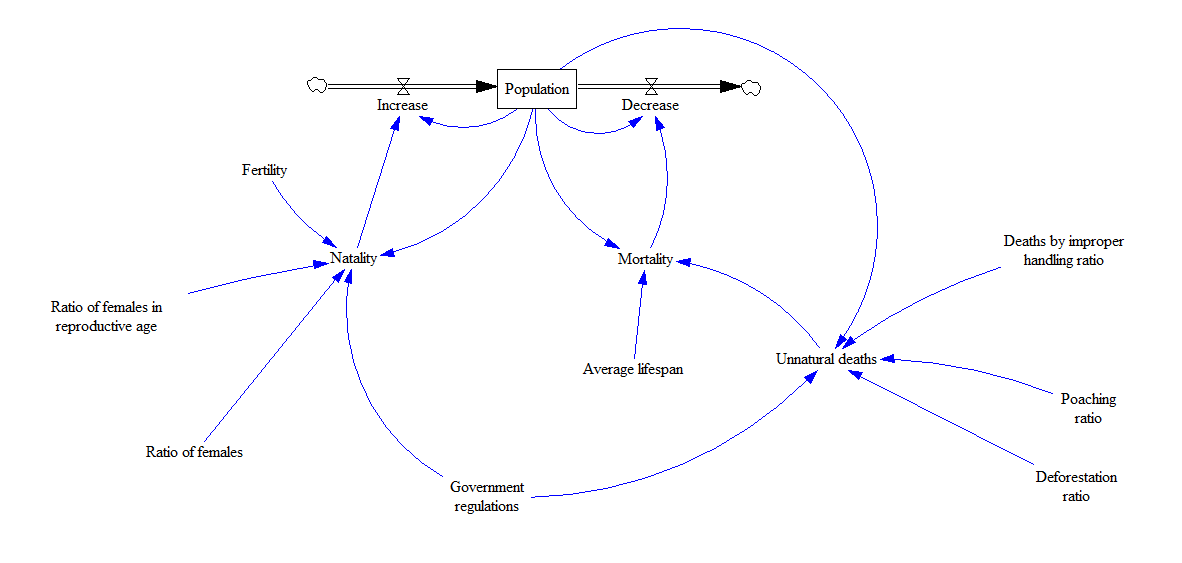Indian Elephant Population in Thailand
Introduction
Contents
- 1 Problem definition
- 2 Method
- 3 Model
- 3.1 Model variables
- 3.1.1 Population
- 3.1.2 Increase
- 3.1.3 Decrease
- 3.1.4 Natality
- 3.1.5 Fertility
- 3.1.6 Ratio of females in reproductive age
- 3.1.7 Ratio of females
- 3.1.8 Government regulation
- 3.1.9 Mortality
- 3.1.10 Average lifespan
- 3.1.11 Unnatural deaths
- 3.1.12 Deaths by improper handling ratio
- 3.1.13 Poaching ratio
- 3.1.14 Deforestation ratio
- 3.1 Model variables
- 4 Results
- 5 Conclusion
- 6 Code
Problem definition
During the course of the 20th century, the population of indian elephants has decreased drastically, mostly due to a significant reduction of elephants' natural habitat, as well as decrease in utilization of elephants in logging industry and shift to a role of a tourist attraction. This model showcases the evolution of elephants' population in Thailand for upcoming 100 years.
Method
The vensim modelling tool was selected for the purpose of this simulation.
Model
Model variables
Population
Number of elephants in Thailand. Starting value 8900. This is the variable that we are examining.
Increase
Number of elephants that are born
=Natality*Population
Decrease
Number of elephants that have died
=Mortality*Population
Natality
Ratio of newly born elephants to elephant population. Amount of newborn elephants equals fertility multiplied by number of females in reproductive age divided by 40*2 (number of reproductive years, multiplied by 2 as elephants pregnancy takes 22-24 months). We then multiply by Governement regualtion ratio.
=((Fertility*((Ratio of females*Population)*Ratio of females in reproductive age)/80)*Government regulations)/Population
Fertility
Amount of calves a female is able to have during her reproductive lifespan. 40% of elephants' population lives in wilderness and the fertility is not affected by stress therefore a wild female is able to have 10 calves, and semi-domesticated female is able to have 7
=0.4*10+0.6*7
Ratio of females in reproductive age
Elephant female can have calves during her 15 to 50 years.
=0.5714
Ratio of females
Ratio of females on elephants' population
=53476
Government regulation
Index of government regulations <0;1>, 1 means no government regulation
=1
Mortality
Ratio of dead elephants on the elephants' population.
=((Population/Average lifespan) + Unnatural deaths)/Population
Average lifespan
=70
Unnatural deaths
Number of deaths that do not happen naturally
=((Deaths by improper handling ratio*Population)+(Poaching ratio*Population))*Government regulations + Population*Deforestation ratio
Deaths by improper handling ratio
Ratio of deaths that happen due to unhuman behavior towards elephants and conditions they have to live in
=0.01685
Poaching ratio
Ratio of deaths that happen because of elephants being hunted either for skin, tusks or to capture young calve
=3.3e-05
Deforestation ratio
Ratio of deforastation in Thailand, this has a close correlation to number of elephants as this the major factor affecting the population
=0.0035
